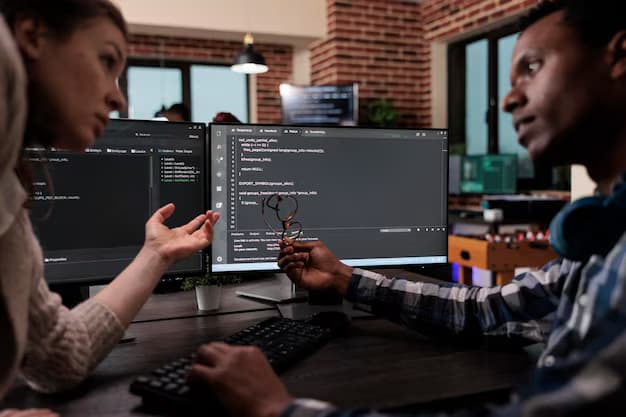Ever wondered if there’s a way to boost the coding efficiency in your organization while simultaneously reducing the occurrence of coding errors? The answer lies in a practice called Pair Programming. It might sound unconventional at first, but this collaborative coding method has remarkable benefits that could transform the way your company works.
The Fundamentals of Pair Programming: Enhancing Collaboration in Coding
Imagine a scenario where two programmers share a single computer to work on a code base collaboratively. This practice, known as pair programming, significantly boosts productivity and decreases the likelihood of introducing code errors. It may sound peculiar initially, but let’s delve into the intricacies of this unique programming methodology.
Delving into Pair Programming
At the crux of pair programming, two developers work in tandem on a single set of code atop a solitary computer. This collaboration leads to the emergence of two distinctive roles within the process: a driver and a navigator.
- Driver: The driver takes on the task of writing the code. They’re in the metaphorical driver’s seat, navigating the codebase and actively implementing code changes;
- Navigator: The navigator, on the other hand, acts as the overseer of the code. They ensure the accuracy of the code written by the driver and spot any potential issues before they escalate.
Developers can effortlessly switch between these roles throughout the process, ensuring a balanced sharing of responsibilities.
Deliberating the Efficiency of Pair Programming
You may question the logic behind having two developers take on a task that seemingly requires just one. It might initially appear to be an inefficient allocation of resources. However, studies conducted by the Association for Computer Machinery (ACM) and the University of Utah’s Computer Science school suggest otherwise. Findings show that while pair programming might extend the coding time by 15%, it simultaneously reduces defects in the code by the same percentage.
Pair programming emerged in the 1990s as a part of the extreme programming software development methodology introduced by Kent Beck. Extreme programming is an agile project management approach that emphasizes short development cycles and frequent releases. This method enhances software quality and accommodates rapidly changing customer requirements.
As per Beck’s perspective, pair programmers maintain focus, brainstorm system refinements, clarify concepts, take the lead when their partner stumbles, and ensure adherence to the team’s established practices. Thus, the benefits of pair programming extend beyond coding to encompass factors such as team spirit, accountability, and enhanced problem-solving skills.
The Remarkable Benefits of Pair Programming
In the realm of programming, pair programming is a practice that has stirred diverse opinions. Despite the debate, agile development organizations are increasingly appreciating the utility of pair programming, recognizing the array of benefits it brings to the table.
Mitigating Bugs and Errors
Referencing the ACM report mentioned previously, one of the key advantages of pair programming is a 15% reduction in defects. The driver-navigator model allows for real-time code review, significantly decreasing oversights, typos, and bugs almost immediately.
Cost-Effectiveness: A Deeper Perspective
The perception of pair programming being expensive is a common misunderstanding. Evaluating it purely on the grounds of resource utilization may convey that double the human resources are engaged than necessary. However, the holistic view reveals a different story. With two developers working in synergy, the time spent on a given project can be significantly lesser compared to a solo developer’s efforts. Additionally, catching and rectifying errors early in the process implies less time spent on corrections, which translates into cost savings in the long run.
Knowledge Transfer and Skill Enhancement
Pair programming paves the way for efficient knowledge sharing. By pairing an inexperienced coder with a seasoned veteran, the former can rapidly acquire the skills and expertise of the latter. This peer learning not only aids in faster onboarding of new coders but also results in a better-informed and capable team across the board.
Higher Job Satisfaction
According to a study titled “Strengthening the Case for Pair Programming,” a staggering 96% of pair programmers had a preference for team-based work, enjoying the camaraderie of their colleagues. Collaborative environments often boost self-assurance, improve networking skills, and foster a healthier professional relationship among the team members. Over time, the resultant enhanced teamwork often manifests in improved quality of work.
Pair Programming in Cyclical Industries
In cyclical industries where market dynamics and requirements constantly evolve, the adaptable nature of Pair Programming becomes particularly valuable. The cyclical nature of these industries often demands rapid adjustments and innovation. By leveraging Pair Programming, teams can respond swiftly to changing circumstances, ensuring their coding efforts remain aligned with industry trends. The collaborative and knowledge-sharing aspects of Pair Programming are especially advantageous in navigating the cyclicality of such sectors, enabling teams to maintain efficiency and minimize errors even in turbulent times.

Guidelines for Optimizing Your Pair Programming Experience
Establish a Rulebook
Before diving headfirst into pair programming, it’s crucial to set up ground rules that are clearly communicated to the entire team. This foundational step sets the tone for effective and efficient pair programming, reducing potential misunderstandings down the line.
Adopt a Gradual Approach
Integrating pair programming into your team’s routine shouldn’t be abrupt. Start small, dedicating a few hours each week to practice this collaborative coding method. Gauge its effectiveness and adjust the frequency based on the observed results and team feedback.
Consider Pairing Compositions
Thoughtfully decide on the developer pairs based on complementary skills and learning potential. Some developers might have unique skill sets that others can benefit from, making them a perfect pair.
Rotate Pairs Regularly
For optimal productivity, avoid having the same pair work together for extended periods. Prolonged pairing could lead to reduced productivity or increased conflict probability. Regularly rotating pairs promotes fresh perspectives and varied learning opportunities.
Plan Ahead for Pair Programming
Implementing pair programming smoothly requires planning. At the start of a new sprint, decide on the pairings, responsibilities, driver-navigator dynamics, and the expected duration. Planning ahead ensures a clear roadmap and reduced confusion during the sprint.
Leverage Online Platforms for Pair Programming
With remote work becoming the norm, pair programming isn’t confined to a single physical workspace. Many developers now find online pair programming, using platforms like Microsoft’s Visual Studio Live Share or GitHub’s Codespaces, more productive and versatile.
Solicit Regular Feedback
Don’t forget to solicit regular feedback from your team on their pair programming experiences. Open dialogues about their likes, challenges, and suggestions help refine your pair programming approach. It also ensures the practice aligns with your team’s preferences and the overall needs of your organization.
Enabling Smooth Collaboration: An Overview of Pair Programming Tools
Pair programming can be significantly enhanced with the right combination of tools and technologies. These tools can be classified into three major categories, each with its unique offerings.
- Integrated Development Environment (IDE) Collaboration: These tools facilitate direct collaboration within the IDE. They allow users to share their IDE but maintain individual control over their inputs;
- Screen Sharing with Dual Control: This class of tools enables one user to share their screen while permitting the second user to view and control the shared screen;
- Multi-user Screen Sharing and Control: The most collaborative category of tools wherein multiple users can share and control screens simultaneously, fostering real-time synchronization.
Based on these categories, here are some prominent tools that optimize pair programming:
Collaborative Integrated Development Environment (IDE) Tools:
- Live Share (VS Code): An extension of Visual Studio Code that provides real-time collaboration without code sync delays;
- Replit: A cloud-based IDE that supports collaborative coding in numerous languages;
- CodeTogether: A plugin that enables end-to-end encrypted, remote pair programming within your preferred IDE.
Single User Sharing, Dual User Remote Control Tools:
- Teletype (for Atom): An Atom package that enables developers to share their workspace with team members;
- Tuple: A tool designed for remote pair programming, providing low-latency screen sharing and remote control;
- Screen.so: Offers fast screen sharing and collaborative browsing for teams.
Multi-user Sharing, Multi-user Remote Control Tools:
- Drovio: A collaborative cloud-based platform for developers with an integrated video chat feature;
- Microsoft Visual Studio Live Share: An extension that allows real-time sharing and live editing within Visual Studio;
- CodePen: A social development environment that facilitates live, on-the-fly previews for front-end development;
- Cloud9: A cloud-based IDE that supports several languages and collaborative coding.
Conclusion
Like any other methodology, pair programming has its own set of challenges. However, acknowledging these potential pitfalls and applying effective counter-measures can help you navigate them successfully. The key lies in understanding your team dynamics, individual strengths, and work preferences. With the right strategies, pair programming can become a powerful tool that elevates the coding process, producing high-quality, error-free code, and a collaborative and educative working environment.
